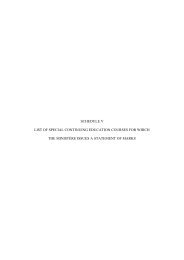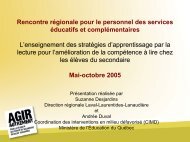Reference Framework for Planning Learning and Evaluation Activities
Reference Framework for Planning Learning and Evaluation Activities
Reference Framework for Planning Learning and Evaluation Activities
You also want an ePaper? Increase the reach of your titles
YUMPU automatically turns print PDFs into web optimized ePapers that Google loves.
The Ministère regularly issues a statement of students’ evaluation results <strong>and</strong>, at the end of their<br />
studies, students receive a statement listing all the competencies they have acquired.<br />
When a student passes a retake of an examination <strong>for</strong> certification purposes, the pass mark becomes<br />
the official result <strong>and</strong> “fail” no longer appears on the report. Support <strong>for</strong> learning <strong>for</strong> the certification of<br />
studies <strong>and</strong> the number of retakes permitted are determined by the educational institution on the basis<br />
of its evaluation st<strong>and</strong>ards <strong>and</strong> methods.<br />
Although the statement is an official document governed by the Basic Vocational Training Regulation, 39<br />
it is not the only way in which results are communicated to the students. The official in<strong>for</strong>mation can be<br />
effectively supplemented in the educational institutions by teacher-student meetings designed to<br />
promote the sharing of relevant observations, in<strong>for</strong>mation <strong>and</strong> data.<br />
With a view to the ongoing development of the competency in the educational institution as well as in<br />
the job market, the communication of results is a key moment between teacher <strong>and</strong> student. Together,<br />
they analyze the student’s progress, his or her achievements <strong>and</strong> what he or she needs to work on in<br />
order to continue developing at the personal <strong>and</strong> vocational levels. The teacher’s involvement in the<br />
student’s progress can help confirm the student’s career choice <strong>and</strong> enrich the teacher’s comments<br />
regarding attitudes to be improved, strengths to be developed <strong>and</strong> so on. This type of contribution<br />
could also encourage a student to choose another field of study which itself would be an educational<br />
success rather than a failure. As much as possible, students should adopt an attitude of lifelong<br />
learning.<br />
Certification of studies<br />
The decision to recognize a competency comes down to a pass/fail decision on the certification<br />
examination. In this way, the Minister can certify the students’ learning.<br />
<strong>Evaluation</strong> <strong>for</strong> certification purposes must uphold the value that society accords to official certification<br />
documents. 40 At the end of a program, if all of the competencies have been acquired, the Minister<br />
certifies that the student has completed his or her vocational training. The Diploma of Vocational<br />
Studies (DVS) <strong>and</strong> the Attestation of Vocational Specialization (AVS) qualify students to enter the job<br />
market. 41<br />
39. According to the Basic Vocational Training Regulation, “persons enrolled in vocational training shall receive a statement of<br />
learning at least twice a year.” R.S.Q., c., I-13.3, s. 448, r. 4.2, s. 18.<br />
40. Policy on the <strong>Evaluation</strong> of <strong>Learning</strong>, p. 21.<br />
41. Under the education re<strong>for</strong>m in secondary schools, a Skills Training Certificate can be awarded in general education. It is<br />
there<strong>for</strong>e still accessible, but is no longer the responsibility of vocational training services.<br />
70 <strong>Planning</strong> <strong>Activities</strong> to Help Students Acquire Competencies




